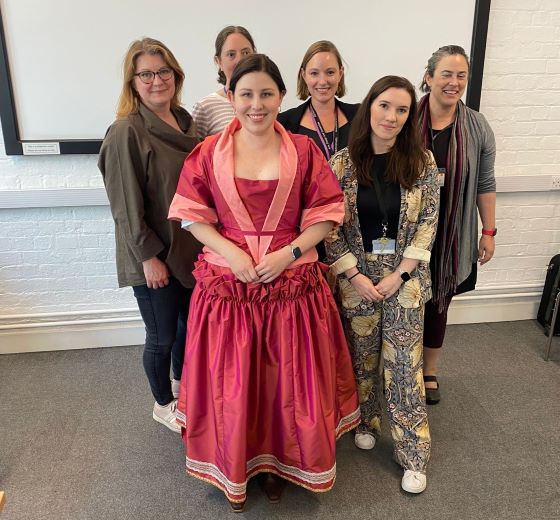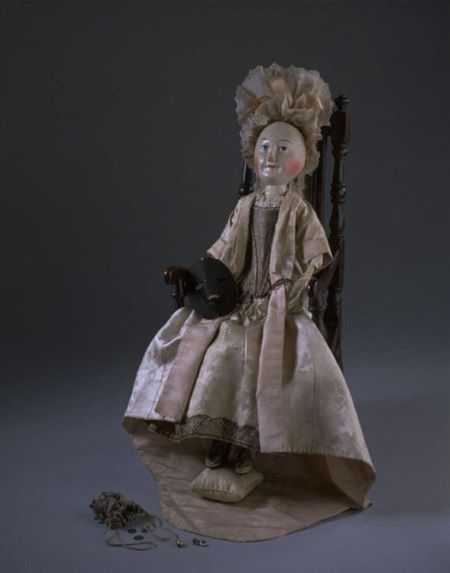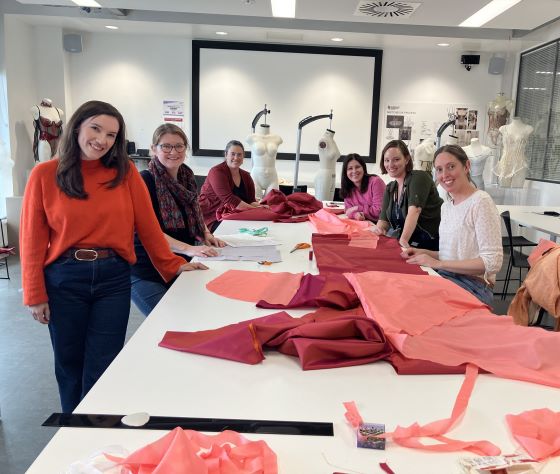A fashion historian has been working with a team of experts from around the world to construct a garment dating back to the 1690s which will help today’s designers and manufacturers better understand how to make fashion more sustainable.
Dr Serena Dyer, Associate Professor of Fashion History at De Montfort University Leicester (DMU), has just held the Making Historical Dress Festival on campus during which dressmakers from the university, other parts of the UK, the USA and Australia made a mantua.

Sarah Bendall in the mantua with the dressmaking team including Dr Dyer (front right)
The mantua became the height of women’s fashion in France, England and Scotland from the 1680s and continued to be manufactured into the 18th century. It was made from a single length of fabric, pleated with a long train and revolutionised the role women played in dressmaking.
Prior to the mantua, garments made for men and women were constructed by male tailors. But the mantua was the first prominent example of women making garments for women.
Very few examples of mantua from the 17th Century have survived and so Dr Dyer, along with Sarah Bendall, from the Australian Catholic University in Melbourne, secured an Arts and Humanities Research Council (AHRC) grant to recreate the dress as part of research titled Making Historical Dress: Hands, Bodies and Methods Network.
They were supported by researchers Rebecca Morrison and Michelle Barker as well as Brooke Welborn and DMU’s Liz Gernerd.
Because there are so few mantuas from this era, the dress constructed at DMU was based on a doll from a collection at the Victoria and Albert Museum in London, known as Lady Clapham. The doll is wearing a miniature replica of the mantua from that period.

The Lady Clapham doll at the V&A wearing a replica mantua
A team of seven world-leading experts in historical garment making took part in the project over two days and showed the design to delegates this weekend.
Dr Dyer explained: “I am a fashion historian who works in recreative practice, which means I try to understand how garments were made in the past by having a go myself.
“While there are lots of existing garments from the 18th Century onwards, prior to that we have really fragmented information.
RELATED NEWS
Find out more about the Making Historical Dress Network
Watch a Fashion Through History episode starring DMU’s Serena Dyer
Explore our DMU Fashion and Textiles courses
“There is so much we can learn about histories of gender, textile manufacture and cutting in an industry which has become less sustainable over time.
“So, we look at how we can we inform modern garment construction and make it more sustainable by circling round to what we learn from historical manufacturing.
“In the 18th century, the length of cloth you start with is where the value is. So, every scrap of that fabric is used and shown off. There was a zero-waste ethos in fashion design.
“This is the thing that has brought us all together for this festival. We are specifically interested in the rise of the mantua, which has a slightly foggy past.
“Prior to the mantua in the 1680s, all garments made for men and women were constructed by a male tailor. But this is the start of manufacturing by women for women.
“The mantua from the 1690s informs us how all garments are constructed right up until the beginning of the 19th century. It all stems back to this one dress.
“There are barely any of them in existence any more from this period and so we are basing this mantua on a doll in a collection from the V&A Museum in London.
“These dolls were dressed in meticulously sewn miniature copies of adult women’s garments.
“If you just blew it up to scale then Sarah, who we are fitting the dress for, would have to be two metres tall, so we used the doll as the basis but had to alter certain measurements.
“This is a pretty unique piece of research and it is really exciting. I think that we have already had so many ‘oh this makes sense’ moments about how the dress was cut.”

The team start cutting and stitching the mantua
As well as creating a replica dress from the 1690s, the conference also involved workshops on different periods of garment making, from 16th century embroidery, to Victorian corset making in Leicestershire and the sustainability of Punk youth culture.
Dr Dyer said it was important to bring people together to help with research into historic dress making and sustainability.
“In the past, recreative practice existed in little groups of people in different places around the world, all learning by ourselves,” she explained.
“This AHRC project was conceived by me and Sarah to create a network around the world of people working on these topics, from the USA to France and South America to Australia. We have already found there are so many things where we have encountered the same problems or have been talking about the same things.”
Dr Dyer’s latest book Labour of the Stitch: The Making and Remaking of Fashionable Georgian Dress was published earlier this year by Cambridge University Press.
Dr Dyer is also the presenter of English Heritage’s Fashion Through History programme on YouTube.
Posted on Wednesday 18 September 2024